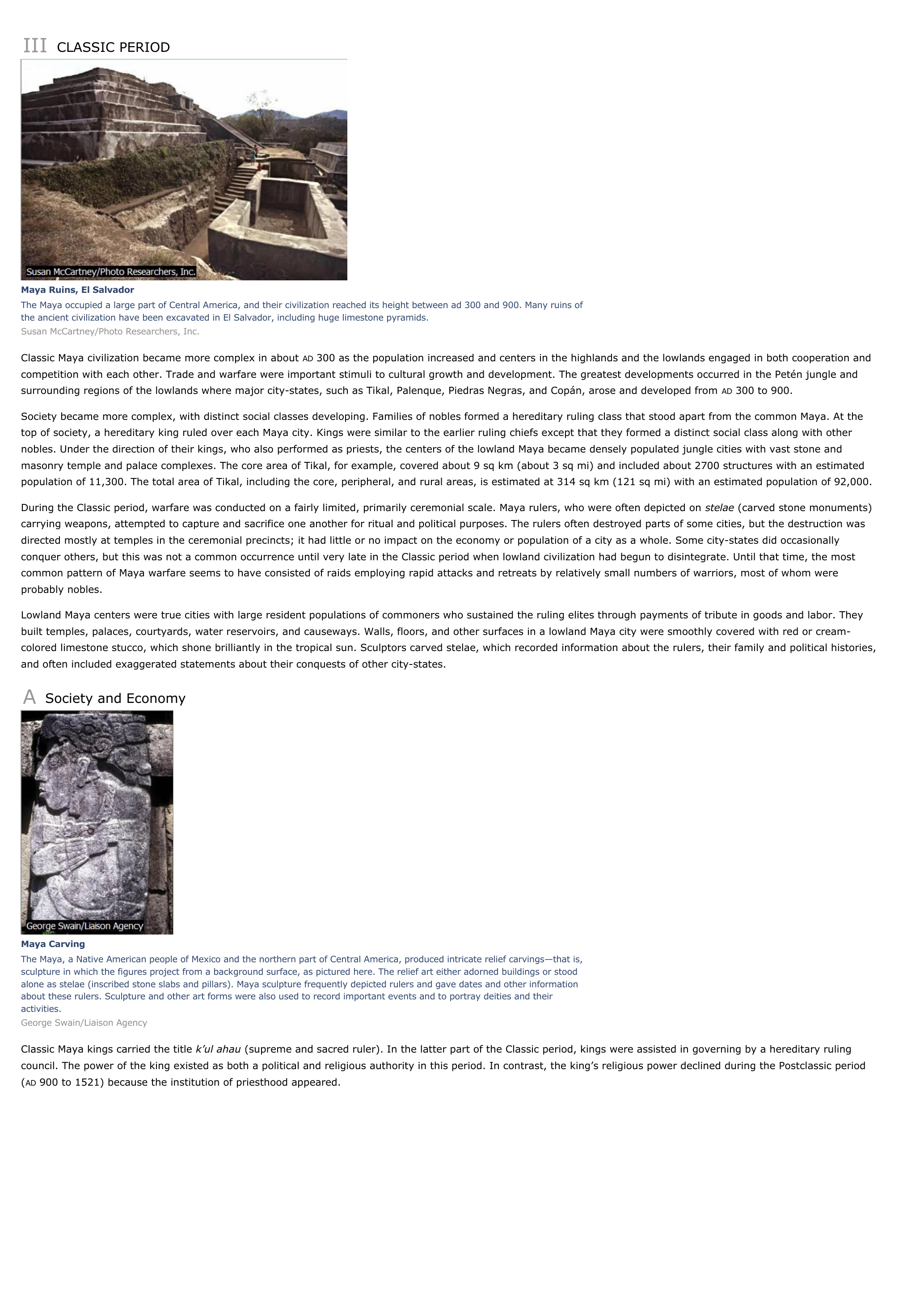Maya Civilization - history.
Publié le 26/05/2013

Extrait du document
«
III CLASSIC PERIOD
Maya Ruins, El SalvadorThe Maya occupied a large part of Central America, and their civilization reached its height between ad 300 and 900.
Many ruins ofthe ancient civilization have been excavated in El Salvador, including huge limestone pyramids.Susan McCartney/Photo Researchers, Inc.
Classic Maya civilization became more complex in about AD 300 as the population increased and centers in the highlands and the lowlands engaged in both cooperation and competition with each other.
Trade and warfare were important stimuli to cultural growth and development.
The greatest developments occurred in the Petén jungle andsurrounding regions of the lowlands where major city-states, such as Tikal, Palenque, Piedras Negras, and Copán, arose and developed from AD 300 to 900.
Society became more complex, with distinct social classes developing.
Families of nobles formed a hereditary ruling class that stood apart from the common Maya.
At thetop of society, a hereditary king ruled over each Maya city.
Kings were similar to the earlier ruling chiefs except that they formed a distinct social class along with othernobles.
Under the direction of their kings, who also performed as priests, the centers of the lowland Maya became densely populated jungle cities with vast stone andmasonry temple and palace complexes.
The core area of Tikal, for example, covered about 9 sq km (about 3 sq mi) and included about 2700 structures with an estimatedpopulation of 11,300.
The total area of Tikal, including the core, peripheral, and rural areas, is estimated at 314 sq km (121 sq mi) with an estimated population of 92,000.
During the Classic period, warfare was conducted on a fairly limited, primarily ceremonial scale.
Maya rulers, who were often depicted on stelae (carved stone monuments) carrying weapons, attempted to capture and sacrifice one another for ritual and political purposes.
The rulers often destroyed parts of some cities, but the destruction wasdirected mostly at temples in the ceremonial precincts; it had little or no impact on the economy or population of a city as a whole.
Some city-states did occasionallyconquer others, but this was not a common occurrence until very late in the Classic period when lowland civilization had begun to disintegrate.
Until that time, the mostcommon pattern of Maya warfare seems to have consisted of raids employing rapid attacks and retreats by relatively small numbers of warriors, most of whom wereprobably nobles.
Lowland Maya centers were true cities with large resident populations of commoners who sustained the ruling elites through payments of tribute in goods and labor.
Theybuilt temples, palaces, courtyards, water reservoirs, and causeways.
Walls, floors, and other surfaces in a lowland Maya city were smoothly covered with red or cream-colored limestone stucco, which shone brilliantly in the tropical sun.
Sculptors carved stelae, which recorded information about the rulers, their family and political histories,and often included exaggerated statements about their conquests of other city-states.
A Society and Economy
Maya CarvingThe Maya, a Native American people of Mexico and the northern part of Central America, produced intricate relief carvings—that is,sculpture in which the figures project from a background surface, as pictured here.
The relief art either adorned buildings or stoodalone as stelae (inscribed stone slabs and pillars).
Maya sculpture frequently depicted rulers and gave dates and other informationabout these rulers.
Sculpture and other art forms were also used to record important events and to portray deities and theiractivities.George Swain/Liaison Agency
Classic Maya kings carried the title k’ul ahau (supreme and sacred ruler).
In the latter part of the Classic period, kings were assisted in governing by a hereditary ruling council.
The power of the king existed as both a political and religious authority in this period.
In contrast, the king’s religious power declined during the Postclassic period(AD 900 to 1521) because the institution of priesthood appeared..
»
↓↓↓ APERÇU DU DOCUMENT ↓↓↓
Liens utiles
- Maya Civilization - History.
- Indus Valley Civilization - history.
- Aegean Civilization - history.
- Maya Civilization.
- Indus Valley Civilization - History.


















